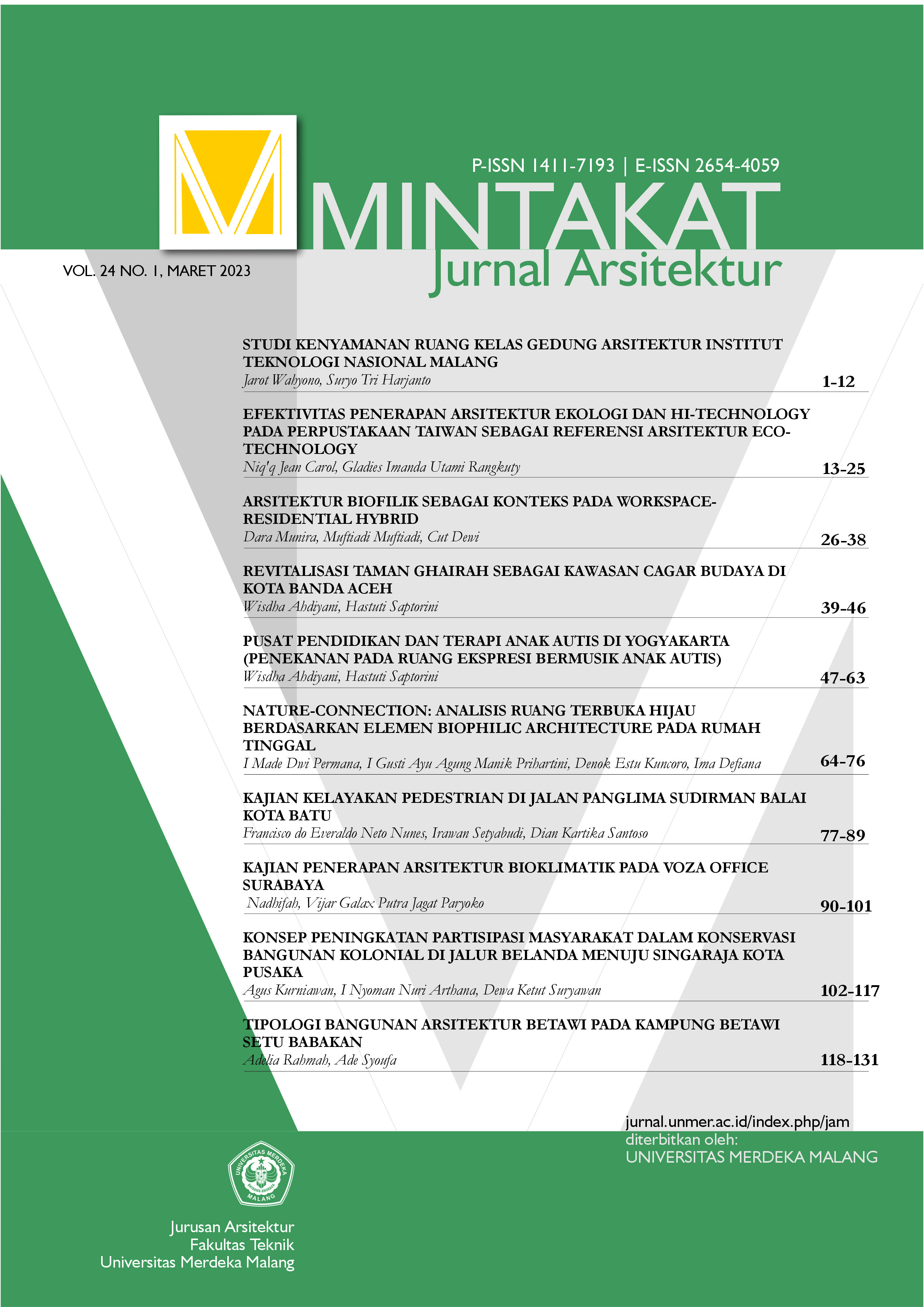Nature-Connection: Analisis Ruang Terbuka Hijau Berdasarkan Elemen Biophilic Architecture pada Rumah Tinggal
DOI:
https://doi.org/10.26905/jam.v24i1.9138Keywords:
biophilic architecture, nature connection, ruang terbuka hijauAbstract
Masifnya pembangunan di bidang arsitektur menyebabkan berkurangnya ketersediaan ruang terbuka hijau, baik di lingkup perkotaan maupun rumah tinggal. Minimnya ruang terbuka hijau dapat berdampak buruk pada lingkungan alam dan kesejahteraan manusia, dimana hubungan kedua aspek tersebut semakin terpisah. Biophilic architecture menjadi sebuah pendekatan desain arsitektur yang mampu menghubungkan antara lingkungan alam dan manusia, khususnya dalam lingkup rumah tinggal. Penelitian bertujuan untuk menganalisis elemen biophilic architecture dan memberikan usulan desain untuk penerapan ruang terbuka hijau sebagai bentuk nature connection pada hunian rumah tinggal. Terdapat tiga rumah tinggal yang dijadikan objek penelitian. Metode penelitian yang digunakan adalah pendekatan deskriptif kualitatif. Pengumpulan data dilakukan dengan mengumpulkan data primer meliputi observasi, sketsa, foto dokumentasi dan data sekunder meliputi studi literatur tentang biophilic architecture. Hasil penelitian menunjukkan bahwa ketiga studi kasus telah menunjukkan karakteristik dari biophilic architecture dan usulan desain terkait kekurangan yang ada pada aspek ruang terbuka hijau pada pekarangan masing-masing rumah.Â
--------------------------------------------------------------------------------------------
The massive development in the field of architecture has reduced the availability of green open spaces, both in urban and residential areas. The lack of green open space causes a negative impact on aspects of the natural environment and human welfare, where the connection of that aspects are increasingly separated. Biophilic architecture is an architectural design approach that is able to connect between the natural and human environment, especially in the housing sphere. This study aims to analyze aspects of biophilic architecture and provide design suggestions for the application of green open spaces as a form of natural connection to residential homes. There are three residential houses that are used as research objects. The research method used is a qualitative descriptive approach. Data collection was carried out by collecting primary data in the form of observations, sketches, photo documentation and secondary data in the form of literature studies on biophilic architecture. The results of the research show that the three case studies have shown biophilic architectural characteristics and design proposals related to the deficiencies that exist in the aspect of green open space in the yard of each house.
Downloads
References
Amin, S. F. A. (2018). Analisis Pemanfaatan Ruang Terbuka Hijau pada Pemukiman Padat di Kecamatan Rappocini Kota Makassar. Jurnal Linear Universitas Muhammadiyah Makassar.
Aristizabal, S. et. al. (2021). Biophilic Office Design: Exploring The Impact of a Multisensory Approach on Human Well-Being. Journal of Environmental Psychology Vol. 77.
Beatley, T. (2011). Biophilic Cities: Integrated Nature into Urban Design and Planning. Washington DC: Island Press
Brontowiyono, W. (2016). Balance of Green Open Space to Support Green Settlement in Yogyakarta Urban Area. Jurnal Sains dan Teknologi Lingkungan, 8(2), 68-79.
Browning, W. et. al. (2014). Fourteen Patterns of Biophilic Design: Improving Health & Well-Being in the Build Environment. New York: Terrapin Bright Green
Day, C., & Gwilliam, J. (2020). Living Architecture, Living Cities. Routledge: New York.
Dias, B. D. (2015). Beyond Sustainability - Biophilic and Regenerative Design in Architecture. European Scientific Journal March 2015 Special Edition.
Isyworo, S. B. et. al. (2019). Exploration Study of Cancer Hospital with Biophilic Design Approach in Bandarlampung. International Journal of Built Environment and Scientific Research, 3(2), 81-98.
Peraturan Daerah Kabupaten Klungkung No. 1 Tahun 2013 Tentang Rencana Tata Ruang dan Wilayah Kabupaten Klungkung Tahun 2013-1033.
Peraturan Daerah Kota Denpasar No. 8 Tahun 2021 Tentang Rencana Tata Ruang dan Wilayah Kota Denpasar Tahun 2021-2041.
Peraturan Daerah Kota Probolinggo Nomor 4 Tahun 2008 Tentang Bangunan Gedung.
Ramzy, N. et. al. (2015). Sustainable Spaces with Psychological Connotation: Historical Architecture as Reference Book for Biomimetic Models with Biophilic Qualities. International Journal of Architectural Research, 9(2), 248-267
Ring, Z. et. al. (2021). Green and Open Space Factor Vienna: A Steering And Evaluation Tool for Urban Green Infrastructure. Journal of Urban Forestry & Urban Greening Vol. 77.
Setyani, W. et. al. (2017). Analisis Ruang Terbuka Hijau dan Kecukupannya di Kota Depok. Buletin Tanah dan Lahan, 1(1), 121-127
Söderlund, J. et. al. (2015). Biophilic Architecture: A Review of the Rationale and Outcomes. AIMS Environmental Science, 2(4), 950-969.
Valero, L. et al. (2022). Living Wall System for Improved Thermal Performance of Facades Located in Tropical Climate: Case Study in Dominican Republic. Journal of Building and Environment, 22, 109419
Yasee, F. R., & Mustafa, F. A. (2022). Visibility of Nature-Connectedness in School Buildings: An Analytical Study Using Biophilic Parameters, Space Syntax, and Space/Nature Syntax. Ain Shams Engineering Journal, 101973
Zhong, W. et. al. (2022). Biophilic Design in Architecture and its Contributions to Health, Well-Being, and Sustainability: A Critical Review. Frontiers of Architectural Research, 11, 114-141














